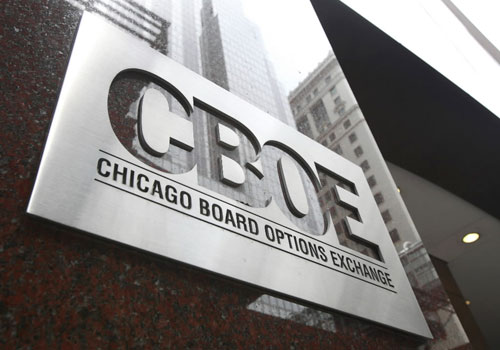The integration of artificial intelligence (AI) and blockchain technology has the potential to transform how capital markets function. AI is enabling better trading strategies, risk management, and generating better trading insights, according to Sankar Krishnan, Executive Vice-President for Banking and Capital Markets at Capgemini.

“It can better predict asset prices and asset allocation strategies. Additionally, AI can power high-frequency trading, identify fraud, and enforce better compliance.” “Across wealth management, we are seeing AI able to help robo-advisors provide better personalization and enhance investment research,” he said.
By monitoring blockchain transactions, AI ensures data integrity, bolster security, and boosts functionality for smart contracts, Krishnan said, adding that AI is also able to analyze trends to determine the accurate valuation for real-world assets.
Anthony Rousseau, Vice President, Head of Brokerage Solutions Product Management at TradeStation, added that AI is currently enhancing the security and scalability of blockchain networks through improved cryptographic methods and consensus mechanisms.
“Decentralized AI (DeAI) platforms are emerging, leveraging both technologies to securely share and trade AI models and data,” he told Traders Magazine.
According to Rousseau, notable projects in this space include SingularityNET and DeepBrain Chain, which are pioneering blockchain-based marketplaces for AI services, such as image processing, language translation and data analysis.
Lars Nyman, CMO of CUDO Compute, said that one noticeable trend is the use of AI to enhance blockchain’s scalability and efficiency. “AI algorithms can optimize transaction processing, making blockchains faster and more reliable,” he said.
Additionally, AI-driven predictive analytics are being employed to forecast market trends in decentralized finance (DeFi), a sector that thrives on the transparency and security of blockchain, he added.
Arthur Meng, CEO and co-founder of Hemera, said there are “some really exciting trends and applications right now”.
AI is being used to make better decisions, boost security, and build trust within blockchain systems, he said.
“For instance, AI can help analyze and predict data patterns, making smart contracts more efficient and reliable. It’s also playing a big role in scaling blockchain networks and improving their overall performance,” he commented.

According to Meng, one notable application is in identity verification, where AI helps streamline the process and make it more secure.
“It’s also being used to manage decentralized autonomous organizations (DAOs), which are essentially self-governing online communities,” he said.
Another important area where AI and blockchain intersect is in tackling data trust and ownership issues, he commented.
“Unlike the opaque data practices of big corporations in the Web2 era, blockchain combined with AI offers a more transparent and trustworthy approach,” Meng said.
Meanwhile, Justin Chapman, Executive Vice President, Global Head of Digital Assets and Financial Markets at Northern Trust Asset Servicing, said: “I haven’t seen any killer use cases hit the market where AI has been built to fully leverage blockchain.”
“We are seeing the usual AI applications around pattern analysis and cyber security. But these are not specifically blockchain-enabled, even if they operate using data held on blockchains,” he commented.
How AI improves blockchain functionality
AI has numerous benefits, particularly within blockchain, however both technologies are still transitioning from proof-of-concepts (POCs) to live transactions. According to Krishnan, considerable progress has been made in the last couple years, as AI is optimizing security and energy consumption, as well as improving data management on a blockchain.
AI is also able to effectively integrate data from blockchains, non-blockchain sources, and unstructured data, including handling images, he said.
“Collectively, AI and blockchain technologies are rethinking traditional capital market processes by enhancing clearing and settlement, pre- and post-trade processes, and ensuring that any errors in data can be picked up before a regulatory filing is made,” he added.
Rousseau argued that the ability to access vast amounts of data on blockchains and harness AI for real-time data analysis enables significant improvements across various aspects of blockchain utilization.
“The combination enables more efficient and transparent processes, giving the possibility of automation where it was not possible before, while driving valuable insights,” he noted.
Nyman added that AI can add a layer of intelligence to blockchain.
“Imagine a blockchain that not only stores data securely but also learns from it,” he said.
According to Nyman, AI can help in detecting fraudulent activities by analyzing transaction patterns in real-time.
Moreover, AI can automate smart contracts, making them more adaptive and self-improving, he said.
“This capability transforms blockchains from static ledgers into dynamic platforms that can evolve based on user behavior and market conditions,” he said.
Nevertheless, according to Chapman, the application of AI to blockchain is in its infancy.
“But if we take AI’s biggest challenges – data quality, data privacy, provenance and trust – and apply blockchain correctly we may be able to take great leaps forward in these areas,” he argued.
“The ability to permission data access to AI capabilities and pass through trust on AI outcomes has huge potential,” he stressed.
Challenges in integrating AI with blockchain
As with all technology integrations, this evolution is not without complexities, particularly concerning the challenges related to privacy and scalability, Rousseau said.
“Like many technologies, security and privacy have become a critical path to new use cases and broad usage,” he said.
According to Nyman, there’s the issue of computational intensity. “AI algorithms require significant processing power, which can strain blockchain networks,” he said.
In addition, data privacy concerns emerge as “AI’s hunger for data can clash with blockchain’s ethos of decentralization and privacy,” he said.

Nyman also argued that “interoperability is… a nightmare”: “Getting different blockchain networks and AI systems to talk to each other is akin to making cats and dogs best friends.”
Chapman added that blockchain is not an efficient database and as such isn’t an ideal source for a LLM.
“The blockchain can augment data and offer province but by design is not a great source location due its cryptographic nature and inherent latency,” he said.
According to Krishnan, while both technologies continue to evolve, they continue to face challenges such as the contrast between decentralized DLT and centralized AI.
As a result, the latency in networks hinder AI-enabled blockchains, he said.
Krishnan stressed there is also a shortage of talent in market with the knowledge and skillset required in integrating both.
Additionally, he said, finding ways to achieve energy efficiency goals is tough given their significant consumption, and it remains a challenge to standardize the technologies for the industry’s overall benefit.
“Financial market intermediaries have a growing role in bringing AI and blockchain together to facilitate industry-wide adoption for leading use cases,” he said.
Leveraging AI in blockchain for trading firms
Trading firms can leverage AI in blockchain to achieve unparalleled market insights and efficiency, Nyman pointed out.
AI can analyze vast amounts of market data stored on blockchains to identify trading opportunities almost instantaneously, he said.

It can also automate trading strategies via smart contracts, ensuring that trades are executed at optimal times without human intervention, he added.
“Imagine having a tireless, emotionless trader that never sleeps and continuously learns from every trade,” Nyman said.
Rousseau added that AI has the capability to analyze large data sets, such as comprehensive market data spanning hundreds of years that provide some interesting opportunities for market research.
“Hedge funds have historically managed analysis for large datasets for decades now, but with the widespread adoption of AI, the playing field has leveled,” he said.
“Now, individuals without previous resources can conduct sophisticated data analysis comparable to larger trading firms,” he added.
Priyanka Saini, SEO Specialist at Knowledge Sourcing Intelligence, commented that trading firms can leverage AI and blockchain in several ways.
She said that in High-Frequency Trading (HFT): The real-time data on the market proper analysis of which takes some time cannot be updated on the blockchain through the application of AI algorithms to trade efficiently.
When using AI in Risk Management, it is possible to predict and control the financial risks based on the large amount of data stored in the block chain, she said.
Finally, Saini said that Blockchain and AI integration decreases the processing of regulatory compliance, “thereby cutting down on the expenses associated with it too”.
Trading firms have a lot to gain by leveraging AI in blockchain applications, agreed Meng.
By using machine learning algorithms, they can analyze market trends more effectively and create predictive models for cryptocurrency price movements, he said.
“This helps in optimizing trading strategies and making more informed decisions,” he said.
Meng added that AI can also enhance risk management by identifying potential risks and mitigating them before they become significant issues.
“Additionally, it can spot arbitrage opportunities – where price differences between markets can be exploited for profit. AI is also instrumental in detecting fraudulent activities, increasing the overall efficiency and security of trading operations,” he said.
“In essence, AI makes trading smarter, safer, and more profitable for firms operating in the blockchain space,” he concluded.




